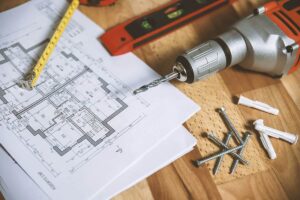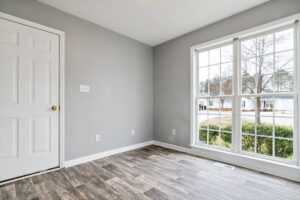Can I Deduct Remodeling Expenses for Rental Property?
Home renovations can seem like a daunting task, but they are often essential for maintaining and increasing the value of your rental property. Depending on the situation, you may be able to deduct some or all of your remodeling costs from your taxes. To understand if you can claim your expenses, let’s dive deeper into the rules.
First, it’s important to distinguish between capital improvements and repairs. Capital improvements refer to changes that add value or extend the useful life of a property, while repairs are usually just fixing existing damage. For example, replacing a damaged window would be considered a repair but installing a new energy-efficient one would be classified as a capital improvement.
Key Takeaways
- Understanding the difference: It’s crucial to distinguish between repairs and capital improvements. Only capital improvements, which add value or prolong the property’s life, can be deductible over time.
- Capitalization and Depreciation: Capital improvements should be capitalized and depreciated over the property’s useful life, often over 27.5 years for residential property.
- Repair costs: These are typically immediately deductible in the year they are incurred.
- Keep records: It’s vital to maintain detailed records of all your expenses. This includes invoices, receipts, and proof of payment.
- Consult a professional: Tax laws can be complex and vary by state. Always consult with a tax professional or certified public accountant to understand what you can and cannot deduct.
Remember, tax laws can change, so it’s important to stay updated and consult a professional to ensure you’re taking full advantage of any potential tax deductions.
How Do I Deduct Rental Property Remodeling Expenses?
To deduct rental property remodeling expenses, you must follow a certain process. Firstly, identify whether the remodeling falls under capital improvements or repairs. Then, proceed to capitalize and depreciate the cost if it’s a capital improvement.
Filing your taxes will require the use of the appropriate IRS forms. For rental property, you would typically use Schedule E of Form 1040. If you are depreciating the cost of a capital improvement, you will need to use Form 4562 to report depreciation.
Throughout this process, remember that accurate record-keeping is crucial. Keep track of all expenses related to the remodeling, including receipts, invoices, and payments. These records will serve as proof of your expenses, should the IRS ever question them.
Lastly, it’s always advisable to consult with a tax professional or certified public accountant when filing taxes, especially when dealing with complex matters like these. They can provide you with specific advice catered to your situation, and ensure you’re maximizing your deductions while staying within the law.
Improvement and Remodeling Expenses for Rental Properties
When it comes to making improvements or remodeling your rental property, there are a variety of expenses that you may incur. Such expenses can include labor costs, materials, permits, and architectural plans.
A capital improvement is a renovation that increases your property’s value, prolongs its useful life, or adapts it to new uses. Examples include adding a new room, upgrading the kitchen or bathroom, installing a new roof, or replacing the HVAC system. These are typically more extensive and costly than repairs, which may include painting, fixing leaks, or repairing broken windows.
As noted earlier, the cost of capital improvements can be capitalized and depreciated over the property’s useful life, which is usually around 27.5 years for residential rentals according to IRS guidelines. Depreciation is a tax term that refers to the gradual deduction of the cost of purchasing and improving a property over its useful life.
On the other hand, if you repair your rental property, you can usually deduct the entire cost of the repair in the year it was incurred. However, repairs must be ordinary, necessary, and reasonable in amount.
In both cases, maintaining detailed records of all expenses is key to claiming these deductions. This includes not only invoices or receipts but also any contracts or documents that detail the nature and cost of work performed. If you ever get audited, these records will be your best defense.
In summary, while you can deduct both capital improvements and repair costs, the way you deduct them differs. Always consult with a tax professional to ensure you’re correctly classifying expenses and maximizing your deductions.
With the right knowledge and proper record-keeping, you can take full advantage of your rental property remodeling expenses.
Rental Property Assets, Maintenance, Cleaning, and Repairs Defined
Let’s delve into some further definitions to better understand which expenses fall under which categories and how they affect your tax deductions.
Rental Property Assets: These are items that add value to your property and are expected to last more than a year. In tax language, these are also referred to as depreciable assets, and they include the property itself and any capital improvements you make.
Maintenance: This involves tasks necessary to keep your property in good working condition but does not necessarily add value or prolong its life. Examples of maintenance tasks can include routine cleaning, servicing of appliances, landscaping, and pest control. These expenses are typically deductible in the year they are incurred.
Cleaning: Cleaning expenses are the costs associated with maintaining cleanliness in your rental property. This could include hiring a cleaning service, purchasing cleaning supplies, or other related expenses. Like maintenance costs, cleaning expenses are usually fully deductible in the year they are incurred.
Repairs: Repairs refer to the costs of fixing or restoring a part of your property that is damaged, deteriorated, or broken. Common examples include fixing a leaky faucet, replacing a broken window, or mending a damaged roof. Repair costs are typically immediately deductible in the year they are incurred, provided they are ordinary, necessary, and reasonable.
It’s important to note that while maintenance, cleaning, and repair costs are typically deductible in the year they’re incurred, capital improvements must be depreciated over the useful life of the asset, usually 27.5 years for residential rental property.
Remember, accurate record-keeping is crucial. Keep track of all expenses, retain all receipts, contracts, and documents, and consult with a tax professional to ensure you’re correctly classifying your expenses and maximizing your deductions.
Summary
The process for deducting rental property remodeling expenses can be complex. Before claiming any deductions, it’s important to understand the difference between repairs and capital improvements. Capital improvements should be capitalized and depreciated over some time, while repair costs are usually immediately deductible in the same year. It’s also essential to keep accurate
When doing your taxes, it’s important to take your time and accurately document any remodeling costs you want to deduct. This could include keeping receipts for all materials purchased, as well as taking photos before and after the renovations. If you take the necessary steps to track your expenses, you can potentially save money on taxes by claiming deductions for your rental property’s remodeling costs.
Additional Resources
For more information about remodeling expenses for rental properties, consult the following resources:
- https://betteraccounting.com/rental-property-remodeling-and-deduction/
- https://www.stessa.com/blog/deducting-remodeling-expenses-for-rental-property/
These resources can provide you with more information on how to properly claim remodeling expenses for rental properties. With the right know-how, you can maximize your savings and ensure that your property is in the best condition possible.
Stay Informed
It’s important to stay up to date with the latest guidelines when it comes to claiming deductions on rental properties, especially if you’re a landlord. Subscribe to newsletters, blogs, and other resources from the IRS, AARP, and local tax advisors for the latest information on filing taxes and claiming deductions.
In addition, consult our blog regularly for more tips and advice about managing rental properties! With the right resources at hand, you can make sure you’re taking all the necessary steps to maximize your savings while ensuring that your rental property is in the best condition possible.
Happy filing!
#### Disclaimer: This blog post is for informational purposes only and should not be taken as tax advice. Please consult your local tax advisor for more information about filing taxes or deducting remodeling expenses on rental properties.
Professional Assistance
A professional can help guide you through the process and provide accurate advice tailored to your specific situation.
When looking for a tax professional, make sure to do your research and ask for recommendations from family, friends, or colleagues. You can also visit sites like Tax Act or TurboTax for more information about finding a professional to assist you.
FAQ
What is considered a capital improvement for a rental property?
Capital improvements are substantial changes that add value to the property or extend its life.
Can I deduct the cost of labor for remodeling my rental property?
Yes, but only if you hire a professional to do the work.
How are repairs and capital improvements treated differently for tax purposes?
Repairs can be deducted as an expense in the year they were made
What type of records should I keep for remodeling expenses?
Keep all receipts for materials purchased, and contracts for professional services hired, and take photos of the property.
Conclusion
In conclusion, understanding and correctly applying the tax codes related to rental property remodeling expenses can lead to significant savings. Remember, improvements that increase the value of your property or extend its useful life are considered capital improvements. On the other hand, repair costs can be deducted in the same year they occur. Keep meticulous records, consult a tax professional if you’re unsure, and stay informed about tax regulations. Always remember this isn’t tax advice, and for specific guidance consult with a tax professional.
For More Details Contact Us








